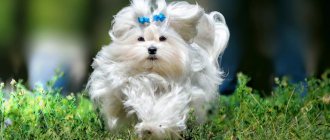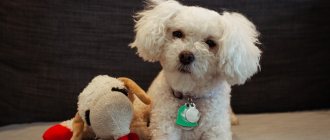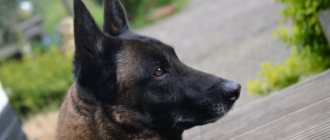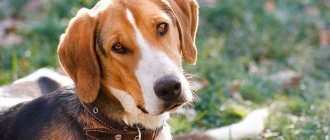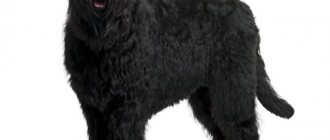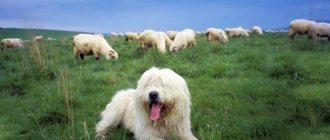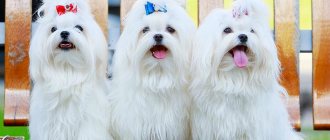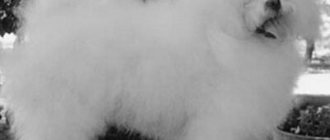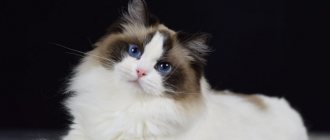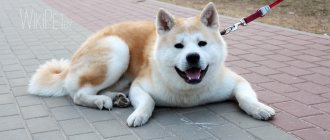A small decorative dog, bred in Russia, has a toy appearance. Despite its cute and harmless appearance, the miniature animal has a strong character, developed intelligence and good memory. The Russian colored lapdog will get along well in a family with children. She loves affection, care and attention very much, but she also requires regular care. Therefore, when purchasing a pet of this breed, the future owner must understand that at the same time he is taking on certain obligations.
Breed standards and description
The Russian Tsvetnaya Bolonka belongs to the category of unrecognized breeds in the RKF system. However, an official standard has been created and approved:
Weight: 3-4 kg;
Height at withers: up to 26 cm.
Color: any except white and spotted.
Eye color: dark or lightened in brown-colored dogs.
Nose: black or matching color.
General appearance: a small dog with curls, slightly protruding eyes, a long tail, ears undocked and drooping.
Since the breed is young, deviations from the description in the standard are possible. Their degree and importance are assessed by an expert at the exhibition.
Disqualifying faults:
- Height more than 28 cm;
- bobtail;
- Not overgrown head;
- Jaw distortion;
- Clear signs of dwarfism;
- Underbite;
- Blue or different colored eyes;
- Non-standard colors;
- Aggressive behavior;
- Uncontrollability;
- Cryptorchidism.
Bolognese
Bologneses (or French lapdogs) are smart, obedient, intelligent dogs, ideal pets, devoted to their owner.
They gained particular popularity several centuries ago in the Italian city of Bologna, which is the main reason for the name of the breed.
The European nobility showed interest in them, but with the course of historical events, the popularity of the Bolognese was lost. Thanks to the efforts and perseverance of breeders, at the beginning of the 20th century the breed began to gain demand again, although at that time there were only about a dozen Bologneses left.
The breed standard was adopted in 1995. The dog's height is 20-30 cm at the withers, weight is 4.5-7 kg. The fur is white, silky, thick, covering the entire body and the high-set tail lying on the back. The furry ears are drooping, and the eyes are dark and extremely expressive. Black nose, eyelids and lips look impressive.
Bolognese is very charming and stylish. They are distrustful of strangers, but dote on their owner.
These dogs live a long time, on average 12-14 years, have excellent health and adapt to any conditions and life situations.
French lapdogs have a fairly high intelligence index for indoor dogs.
They love attention and praise. These are the most sociable dogs from the group of lapdogs.
History of the Russian colored lapdog
In the USSR, service or hunting breeds of dogs were developed. Therefore, people en masse adopted pets of unknown origin as companions. A purebred decorative dog was rather an exception, but “grandmother’s lapdogs” lived in every yard. The creators of the breed set the task: to obtain monotonous companion pets with an easy-going character. For this they used two main breeds:
- Maltese dogs;
- Shih Tzu.
Since the Maltese in those days were not ideally purebred, the blood of poodles and Scottish terriers were probably included in the breeding. The breed was bred in Leningrad in the 60s. The Maltese was given the coat and body structure, and the Shih Tzu was given a sweet expression in the eyes and a strong bone structure.
At the end of the 80s of the 20th century, the Russian colored lapdog was already considered a mature breed. However, the economic crisis and perestroika almost led to its disappearance. The situation was changed after 5-6 years and the livestock was restored. Today the breed is popular domestically and in Europe. The RKF system is working on its recognition at the IKF level.
Origin
The beginning of the development of the breed can be considered in 1950, when, after World War II, small decorative dogs began to be massively imported to the city of Leningrad for home keeping. They immediately gained fans, who began active work on selecting puppies and establishing clear standards. A year later they managed to get the first pair of dogs, which became the progenitors of modern colored lapdogs.
Various types of lap dogs, Pekingese, Shih Tzu, miniature poodles, Lhasa Apso and simple yard dogs took part in the creation of the breed. Today, the Russian Tsvetnaya is recognized only by domestic dog breeding organizations. The world famous FCI breed was never identified as a separate breed.
Behavior and temperament
Fans of the breed note that the main thing is character and behavior, and appearance is secondary.
Positive traits:
- Cheerfulness;
- Cleanliness;
- Energy;
- Stress resistance;
- Playfulness;
- Friendliness.
Negative features:
- There are uncontrollable individuals;
- They may bark frequently.
Historical reference
Not many dogs were bred in the vastness of the USSR that gained worldwide popularity. World statistics show that the most famous breed is the Russian Toy, followed by the lapdog in second place. Note that lapdogs are a group of dogs, and the Russian Tsvetnaya lapdog is one of the most common varieties.
The history of the breed begins in Leningrad and affects many aspects of the cynological life of Russia. In the middle of the 20th century, a group of enthusiasts set themselves the goal of breeding a new decorative, dwarf breed. In addition, the group set a very high goal, deciding that their breed would become a national treasure of the country.
No serious breakthroughs in breeding work have been observed for 20 years. Despite a competent approach, enthusiasts were unable to attract volunteers and additional resources. Reviews with a touch of negativity appeared in the media and expert notes. The diversity and small numbers of the new breed were especially noted. Experts called the timing unfortunate and the working conditions difficult.
As you might have guessed, the negative sentiments of experts did not stop fans of the breed. By the way, the very idea of creating the breed appeared after the deliberate mating of a brown and white lapdog. The first black puppy appeared in the litter - Tin-tin. The baby was born petite, curly and very pretty. The next logical step was to breed the unique Tin-Tin with a suitable male, but this did not happen in Leningrad. Almost a year later, the dog Zhuzha, another female with a suitable phenotype, was found and purchased from a touring circus.
Only a few years later, Tin-Tin gave birth to a litter with a coffee puppy. Later, the breeders managed to obtain two more litters with a suitable phenotype. Only by the end of the 50s, through strict selection and standardization, breeders managed to achieve the inclusion of the breed standard in the register of the kennel club. At the time of its formation, the Russian Tsvetnaya Bolonka was considered a breed group with a variety of colors and insignificant differences in phenotype.
By 1962, breeders managed to achieve approval of a temporary breed standard. From that moment on, the Russian Tsvetnaya Bolonka was considered a separate but young breed of dog. After that, for another 3 years, the standard was constantly adjusted and supplemented.
By 1965, 278 lap dogs were shown at the largest exhibition in Leningrad, most of them Russian colored. This progress was considered a breakthrough, especially considering that breeding work began with the “impossible” idea of a group of enthusiasts.
A year after recognition, in 1967, the Russian Tsvetnaya lap dog shone at the largest exhibition in Moscow. In the early 70s, the kennel club registered more than 200 dogs that met the standard. Despite their success, dogs were still considered phenotypes. By the way, almost 100 dogs lived in Moscow.
As with any story, the boom is followed by the bust. The critical time for the Russian Tsvetnaya lap dog began in the 80s. In Leningrad, the popularity of the breed sharply decreased, which led to a significant decrease in the number of livestock. By the 90s, only a few representatives of the breed remained in Leningrad. The situation was saved in Moscow; here the livestock was not only maintained, but also grew. Even several large breeding plants have appeared in Moscow.
By the end of the 20th century, in addition to Russian breeders, European nurseries became interested in breeding work. Of course, Russian breeders played the main role in the development of the breed.
The vigorous work and opening of nurseries attracted the attention of foreign experts and created additional hype around the breed
Note that the largest nurseries exist and compete to this day. Healthy competition is always good, especially when it helps improve the breed. The hard work of fans of the breed led to the fact that the Russian Tsvetnaya lap dog returned to its homeland in St. Petersburg (Leningrad). Breeders in the homeland of the breed “shook themselves out of their slumber” and set about restoring the livestock with renewed vigor. By the mid-90s, several large breed clubs opened in St. Petersburg.
Who is this dog suitable for?
Russian color is chosen by different people:
- pensioners;
- active youth;
- lonely;
- teenagers;
- large families with children;
- inexperienced dog breeders;
- travelers.
Definitely, these dogs are not suitable for athletes and strict disciplinarians. Russian colored lapdogs love attention, games, they have adequate behavior, but the desire to turn them into a service shepherd dog or a guard dog will lead to a broken psyche and loss of breed characteristics. They can work as a “bell”, notifying about the arrival of guests.
Due to their friendly nature, they easily fit into a pack of other pets. They get along well with children and play carefully with them.
She will not let you get bored, but delicately asks for attention and senses the person’s mood. The lapdog is peaceful and friendly with other people's dogs; fights are impossible due to the complete absence of aggression.
Character
The Russian lapdog is a lively, sociable and affectionate dog. She never imposes her presence on her owner. In general, it is quite easy and simple to communicate with her. The standards clearly indicate that the dog must have a balanced psyche and a calm disposition. A small dog will in no case become an obstacle to other pets living in the same territory - it will try to find a common language with everyone. Discontent and some squabbles can only occur if dogs of the same breed live nearby.
This miniature specimen knows its worth very well and behaves with dignity among its older brothers. But at the slightest hint of aggression on the part of another animal, it will try to leave, as it does not like to get into fights.
The lapdog is especially picky about people. When she gets into a new family, she will instantly determine her favorite and will follow him everywhere. A dog is not as attached to a place as it is to a person. Therefore, the animal easily adapts on trips, in nature and in a new place of residence - as long as its adored owner is always nearby.
Features of maintenance and care
Russian colored lapdogs, unlike other decorative breeds, are unpretentious in care and maintenance. Adult pets grow up to be little larger than a cat, so they get along well in an apartment. They feel great in the city and enjoy going for walks. There are simple rules that everyone follows.
These dogs are not intended to live outside (in a kennel or enclosure).
- Firstly, they are small and it is difficult for them to maintain normal body temperature in cold air.
- Secondly, lap dogs are created to live next to humans. Without communication, they become sad and their character deteriorates. However, long walks are tolerated without problems if they move and the owner is nearby. Dense wool protects from frost and rain.
From the Shih Tzu, Russian colored lapdogs inherited strong bones and bulging eyes, but the length of the muzzle remained normal. Thanks to this, the dog tolerates the heat well , that is, such dogs breathe normally, and the air has time to cool. For example, other short-faced breeds (Pekingese, French bulldogs, pugs) do not tolerate heat well and suffer from problems with the nasopharynx.
You can walk with a Russian colored lapdog for more than an hour in warm weather. Do not forget that extreme heat (over 35 degrees) is harmful to any dog.
Despite their endurance and love for walks, adult individuals only need 2 walks a day for 30 minutes. Puppies up to 8-9 months are taken out more often so that they do not have rickets due to a deficiency of vitamins, microelements and physical activity, and they also relieve themselves.
In winter, Russian colored lapdogs do not need clothing. If walks in the city take place along paths with reagents, then special boots will help save the paws from damage. Many dogs of this breed do not have very sensitive skin, but the hair between the pads is carefully trimmed, and the “sole” is lubricated with a nourishing cream in case of dryness or cracks.
It is comfortable to live with a Russian colored lapdog. Thanks to its size, traveling with a dog is not a hassle; it is even carried in the cabin of the plane, and not in the luggage compartment.
Feeding
The breed is fed the same as other dogs - 25 g of meat per 1 kg of weight. An adult dog with a body weight of 5 kg is given 125 g of beef, rabbit, turkey, fish 1.5 times more - 187 g. The amount of tripe and chicken is increased, since their calorie content is lower.
Main products:
- Raw meat and offal (except pork) - every day.
- Fermented milk products - 3-4 times a week, replaces one feeding with meat.
- Rice or buckwheat porridge - every day, about 30-50 grams.
- Sea fish – 1-2 times a week.
- Vegetables, greens - every day, you can replace porridge.
- Egg – 1 time per week.
The Russian Tsvetnoy lapdog is suitable for industrial foods for small dogs with a reduced content of grains. When choosing, take into account the age, activity and health of the dog. Supplements and vitamins are prescribed by a veterinarian. Important: do not overfeed your pet. Portions are increased based on the dog's needs.
Care of fur, claws and teeth
Grooming for Russians is simple and therefore enjoyable. The coat is soft, but not like that of poodles, maltese or Yorkshire terriers. Grooming rules:
- Combing 2-3 times a week.
- Wash every 1-2 times a month.
- Comb only dry hair.
- Do not use a hair dryer or compressor.
- Long hair above the eyes is pinned up without pulling the skin.
- Wool can be braided.
- The haircut is only suitable for non-show dogs.
Puppies and dogs during the shedding period are brushed every other day. Tools and means for grooming:
- Shampoo for dogs with curly hair.
- Conditioner for easy combing (optional).
- Double-sided brush with plastic or wooden fine teeth.
- Colt cutter.
- Face brush (small, fine-toothed comb).
A massage brush or slicker will not comb through thick and curly hair. It is better to disassemble tangles by hand, but as a last resort, use a special device.
Nails should wear down when walking on asphalt, gravel (good for paws) and tiles. If they interfere with movements, they are shortened in a veterinary clinic or independently using forceps to size. Sometimes an engraver is used.
Plaque in the ears indicates health problems. A veterinarian's consultation is required. Regular dirt is wiped with a cotton pad soaked in hydrogen peroxide. The hairs in the ear canal are carefully plucked out with tweezers.
The eyes should not fester, but dust and dirt accumulate in the folds near the nose. They are removed with a damp cotton swab as they become dirty. Teeth are cleaned in a veterinary clinic. To prevent plaque, the lapdog is given pieces of cartilage, carrots, and a green apple.
Nutrition
It makes no sense to say that nutrition plays almost the leading role in the formation of canine immunity. Breeders at offline meetings and on the Internet loudly argue among themselves which is better - factory feed or natural products.
Black Russian lapdog puppies
And the owner and his pet solve this issue quietly and peacefully in their kitchen. In the end, this is a purely individual matter. Is it convenient for the owner to feed the dog dry food? Great. The main thing is to ensure that the food is of high quality, and also measure doses in accordance with the standards prescribed on the packaging. Vitamins and minerals are already included in the diet, so there is no need to worry about it further. In addition, the packaging is convenient to take on trips.
Do you have enough time for daily cooking? Also a great option, although more troublesome. But there will always be variety in the bowl. The dog will happily eat meat, sea fish, vegetables, fruits, cereals, and sour milk. The lapdog especially reveres quail eggs.
In both cases, it is important to provide the dog with drinking water by placing the bowl in a place accessible to the animal. Any owner of the breed should know that Russian lapdog puppies eat up to six times the first three months, and then one feeding is removed every month. By the age of one year, the dog eats twice a day, but does not remain hungry, because the amount of food in the plate has gradually increased.
The general rule for all breeders is not to feed the dog from your table, despite its sad and sad look. You should not give sweets, smoked foods, salty foods, potatoes, legumes, as well as foods that lead to gas formation.
Education and training
Owners of Russian colored lapdogs note good training abilities. The ancestors of this breed were pinschers (Maltese), from them they inherited a lively mind, and from the Shih Tzu a sense of self-esteem and the ability to solve problems independently. Russian colored lap dogs are trained to:
- General obedience course;
- Agility;
- Obidience;
- Circus training.
Household training is sufficient for such dogs. They quickly get used to the rules of behavior in their new home. Puppies are playful and easy to attract with toys or just petting. The first months of training take place in an informal setting.
Russian colored lapdogs do not tolerate violence in any form, and respond to good treatment with devotion and attentiveness.
For an adult dog of this breed, a place in the house for a toilet is often arranged. You will need a tray and absorbent diapers. The puppy is brought there as soon as he begins to worry, whine and look for a secluded corner. Most Russian colored lapdogs quickly get used to being in a litter box or in diapers.
Possible diseases
Typical diseases that a Russian colored lapdog can catch are related to the musculoskeletal system. The most popular among them are diseases of the spine. The owner must ensure that the pet is not high from the floor level. The dog may fall and get injured.
Ophthalmological diseases – tearing, entropion of the eyelids – cannot be excluded. It is better to collect bangs in a bun, pinning them with an elastic band. A popular orthodontic problem is tartar. It can be solved by regular brushing and special bones on which the dog sharpens its teeth and strengthens its gums.
In general, the pet is very resistant to illnesses. It's easy to explain. The breed was created spontaneously; there were many connections with mongrels. And they are famous for their excellent immunity. However, prevention in the form of healthy food, a balanced diet, and timely vaccines will not hurt.
Vaccinations are done three times in the first year of life: at two months, at three months, and also at six months. Then the dog is vaccinated annually at a certain period. With the help of vaccinations, you can prevent a number of dangerous diseases - rabies, leptospirosis, hepatitis, plague, etc.
Health and life expectancy
Russian colored lapdogs live on average 16-18 years . Diseases are common in the breed, including hereditary ones:
- Perthes disease;
- Eye pathologies;
- Allergies;
- Ear problems (inflammation, ear mites);
- Patella luxation;
- Eczema;
- Dermatitis;
- Obesity.
Breeders and owners of Russian colored lapdogs claim that these dogs have high resistance to infectious diseases . They attribute this to genetics.
How to choose a puppy
Choosing a colored lapdog puppy is a responsible process that will result in the appearance of a charming little friend in your home. But at the stage of selecting a pet, it is easy to make a mistake - scammers take advantage of the fact that the breed is still little known, and often offer ordinary fluffy mongrels under the guise of a purebred dog. What will grow out of these cute puppies later is a big question.
Fraudsters take advantage of the fact that the breed is still little known and often offer ordinary fluffy mongrels under the guise of a purebred dog.
Therefore, the first and mandatory rule: you should buy a colored lapdog puppy only from a breeding kennel that breeds this breed. The number of such nurseries is growing, they are all located in Russia, so it will not be difficult to follow the second rule: choose a puppy not from a photograph, but go for it in person. This way you can evaluate the conditions for raising the baby, the condition of its parents and littermates, and at the same time make friends with the breeder, whose experience and advice will definitely be useful to you.
When choosing a puppy, be sure to meet its mother
Buy a puppy that has been fully vaccinated and post-vaccination quarantine. The ideal age is four to five months. Yes, this is not quite a baby anymore, but at this age it is already possible to clearly recognize many of the breed’s qualities and shortcomings
What makes sense to pay close attention to:
- on the shape of the head - it should be round, with a sharp stop and a short muzzle;
- on the dental system - even if not all the teeth have changed yet, the puppy’s bite is clearly visible, any deviations from the “scissors” are considered a defect;
- on the color and quality of the coat - already by three months the flowers have sufficient hair in all parts of the body, including the head and tail, both the awn and the undercoat must be developed, and the breed color cannot be white or spotted.
Photo
A selection of photos of Russian lap dogs.
Beagle
"Beagle"
Dogs of the Beagle breed appeared in medieval England. The royal nobility used them to track deer and roe deer and hunt hares. This breed of small dogs instantly captivates with its remarkable charm, and their charming eyes seem to look straight into your soul, especially if the animal has set the goal of begging you for a treat. These dogs have a short and dense coat, standard height at the withers varies between 33-40 cm and a weight of 9-14 kg. Beagles have an excellent temperament - they are energetic and intelligent, playful, loyal and friendly. Their keen sense of smell can sometimes make walks especially interesting as they try to keep track of every scent they encounter.
Kinds
There are several types of lap dogs. They are united by several parameters: miniature, friendliness and lush fur. Mostly women like to have such dogs. Let's consider the popular types of lapdogs, except Russian:
- Bichon Frize. The second name of the dog is “little lion”. These are small and very fluffy dogs that resemble stuffed animals. The Bichon Frize is a good decorative breed, perfect for apartment living.
- Havanskaya. This dog was bred by crossing other types from this group. He is small, has a pleasant appearance, very sweet and affectionate.
- Bolognese. The dog's homeland is France. She is considered the most sociable lap dog.
- Coton de Tulear. A very mischievous and nimble dog. He is filled with energy. The homeland of Coton de Tulear is the famous island of Madagascar.
- Maltese. One of the oldest representatives of this group of dogs. The Maltese is very fluffy.
- Levchen. The dog is very similar to a large Persian cat. He is just as graceful and fluffy. They cut it so that it resembles a decorative lion with a lush mane.
Price
Having such a “living toy” at home is a great happiness. But, unfortunately, in Russia you can’t buy it in every city. Therefore, if you want to become the owner of a purebred Russian lap dog, you will have to go to the capital, that is, to Moscow, to get it.
It is in this city that there are 2 kennels where such dogs are professionally bred. There, the buyer will be provided with information about the health status of each puppy and will be helped to choose one. The price of a Russian lap dog from a nursery is 20-25 thousand rubles.
If you want to save money, you can use another method of purchasing - from your own hands. The cost of a puppy of this breed from breeders for 2022 is 8-15 thousand rubles. Individuals painted black or brown are considered rare, so they can be more expensive.
Dwarf Maltese
The dog, which appeared as a subtype of the American Standard Maltese, is not recognized, is not allowed to show, but is popular. These pets are very small (weigh up to 2.5 kg) and cute. The “baby face” look with large eyes and a short, upturned muzzle is popular.
Such changes in appearance are a defect of the breed; puppies with abnormal skull structure should be discarded. But enterprising breeders considered this a successful marketing ploy. Animals with similar defects (short muzzle, underweight, small size) often get sick and injured.
In general, doggies are no different from their “big” brothers: white straight hair, black eyes, perky disposition, affection. They also make good companions and family pets. The average cost of puppies is 25,000 rubles.
